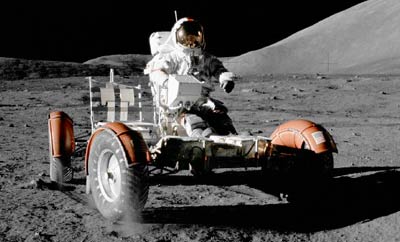Lunar rovers past and futureby Anthony Young
|
| “Going to the Moon was still a long way off, and he [von Braun] was talking about driving a car a quarter of a million miles away!” said Cernan. |
In the early sixties, von Braun envisioned a manned lunar rover to aid astronauts on future missions to the moon. Eugene Cernan, commander of Apollo 17, recalled a face-to-face meeting during the Gemini program with von Braun. The noted rocket scientist wanted to talk to the astronauts about more than getting to the Moon, but to explore its surface, something that had always been von Braun’s dream.
“There were six to eight of us at this table,” Cernan says, “and von Braun said, with his distinctive German accent, ‘Don’t you worry about getting to the Moon—I will get you there. It’s what you do when you get there that’s important.’ And that’s when he said, ‘You’ll probably be driving a car on the Moon.’ Going to the Moon was still a long way off, and he was talking about driving a car a quarter of a million miles away!”
Beginning in 1964, MSFC pursued several rover concepts, including pressurized vehicles. The prototypes built by Grumman and other contractors were too big and heavy, and were abandoned. MSFC looked for lighter solutions. The goal of landing on the Moon consumed much of Marshall’s time but as that certainty loomed, Marshall again started work on the rover in earnest. On July 11, 1969, the LRV Task Team issued a request for proposals from various NASA contractors. Two weeks later, with the euphoria of the successful flight and return of the Apollo 11 crew, a bidders briefing was held at NASA’s Michoud Assembly Facility east of New Orleans. MSFC evaluated the LRV contractor proposals during August and September. On October 28, Boeing was awarded the $19.6 million contract for the Lunar Roving Vehicle, with delivery of LRV-1 to Kennedy Space Center scheduled for April 1971.
Von Braun had placed Saverio Morea, who had overseen development of the F-1 engine, in charge of the LRV program. There were three primary targets Boeing’s LRV had to meet: performance, schedule and cost; the LRV had to meet all the demanding performance goals under actual conditions on the Moon, it had to be delivered on time and it had to be within Boeing’s lowest bidder figure. Morea made sure the contract was drafted to protect NASA’s interests in all three areas. In addition, Boeing had to build 1-G vehicles for astronaut training and other test units as well. Basically, Boeing had to design, develop, test, build and deliver the LRV in time for Apollo 15 and have it perform flawlessly on the Moon or suffer financial consequences.
| Basically, Boeing had to design, develop, test, build and deliver the LRV in time for Apollo 15 and have it perform flawlessly on the Moon or suffer financial consequences. |
Design and development of the LRV took place at Boeing’s Kent, Washington facility. To get the most compact vehicle possible for its trip to the moon mounted to the lunar module, Boeing designed the LRV to have a forward chassis, center chassis and rear chassis; the forward and rear chassis with their suspension, wheels and tires would fold inward on top of the center chassis. The wheels and suspension were designed to pivot toward the centerline of the vehicle reducing the envelope even further. Aluminum was used extensively throughout the LRV. The chassis were fabricated from 2219 alloy. The wheels were spun aluminum with .83mm diameter strand woven steel mesh zinc plated tires. To this were riveted titanium chevrons that covered 50 percent of the tire’s contact area. Within each tire section was a bump stop to prevent collapse of the tire section in the event of hard impact. The DC motors transmitted torque through 80:1 harmonic reduction drives. If for some reason a motor or harmonic drive unit failed, it could be disengaged from the control console and could free-wheel. The suspension was double wishbone with upper and lower torsion bar and a damper unit between the chassis and upper wishbone. Front and rear wheel steering permitted very tight turning radius using steering motors; front or rear steering could also be disengaged if necessary. Steering, accelerating, braking and reversing were performed using an ingenious T-handle on the crew console.
The LRV would also carry equipment that would televise and film their activity, store experiments and provide considerable stowage for tools and other equipment as well as lunar sample stowage. The most distinctive appendage on the LRV was the umbrella-like gold mesh high-gain S-band antenna that would beam live images from the color TV camera. There was also a low-gain antenna and a 16mm film data acquisition camera. Fresh black and white and color film magazines for the astronauts’ Hasselblad 70mm cameras were stored underneath the right-hand seat. The area behind the seats kept all the other equipment used for exploration, sampling and storage. Various trainers had to be completed before the LRVs destined for the Moon so training could start as soon as possible. Boeing and its chief subcontractor, General Motors, moved with amazing speed in the design, testing and production of the LRV. The first LRV was evaluated by NASA at Boeing’s Washington facility and approved for shipment to KSC two months ahead of schedule.
